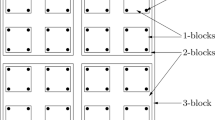Abstract
We present in this paper a way to perform the mapping of the spin-1 Blume–Capel model into a random-cluster model, and analyze thermodynamic properties of the former model in terms of geometric properties of clusters generated in the random-cluster representation. It is shown that there are two different relevant types of cluster, and that one of them is the exact analogue of the type of cluster generated in the Ising model. We use this result to derive expressions for thermodynamical properties on the second-order transition line which are equivalent to the ones found in the Ising model. The other type of cluster is responsible for the first-order transitions, and we may see the tricritical point as a point where both types of cluster compete on the same footing.
Similar content being viewed by others
REFERENCES
P. W. Kastelyn and C. M. Fortuin, J. Phys. Soc. Japan Suppl. 26:11 (1969).
C. M. Fortuin and P. W. Kastelyn, On the random-cluster model, Physica 57:536 (1972).
C. M. Fortuin, P. W. Kastelyn, and J. Ginibre, Correlation inequalities on some partially ordered sets, Commun. Math. Phys. 22:89 (1971).
D. Ioffe, Exact large deviation bonds up to Tc for the Ising model in two dimensions, Probab. Theory Relat. Fields 102:313 (1995).
A. Pisztora, Surface order deviations for the Ising, Potts and percolation models, Probab. Theory Relat. Fields 104:427 (1996).
M. Aizenman, J. T. Chayes, L. Chayes, and C. M. Newman, x-y 2 Ising and Potts model, J. Stat. Phys. 50:1 (1988).
C.-E. Pfister and Y. Velenik, Random-cluster representation of the Ashkin-Teller model, J. Stat. Phys. 88:1295 (1997).
R. H. Swendsen and J. S. Wang, Nonuniversal critical dynamics in Monte Carlo simula-tions, Phys. Rev. Lett. 58:86 (1987).
M. B. Bouabci and C. E. I. Carneiro, Eliminating metastability in first-order phase transi-tions, Phys. Rev. B 54:359 (1996).
M. Blume, V. J. Emery, and R. B. Griffiths, Ising model for the λ transition and phase separation in He 3 -He 4 mixtures, Phys. Rev. A 4:1071 (1971).
H. W. J. Blote, E. Luitjen, and J. R. Heringa, Ising universality in three dimensions: A Monte Carlo study, J. Phys. A 28:6289 (1995).
M. Blume, Theory of the first-order magnetic phase change in UO2, Phys. Rev. 141:517 (1966).
H. W. Capel, On the possibility of first-order phase-transitions in Ising systems of triplet ions with zero-field, Physica 32:966 (1966).
I. D. Lawrie and S. Sarbach, Theory of tricritical points, in Phase Transitions and Critical Phenomena, J. L. Lebowitz and C. Domb, eds. (Academic, London, 1984), Vol. 8.
U. Wolff, Collective Monte Carlo updating for spin systems, Phys. Rev. Lett. 62:361 (1989).
G. T. Barkema and M. E. J. Newman, New Monte Carlo algorithms for classical spin systems, in Monte Carlo Methods in Chemical Physics (Wiley, New York, 1997).
D. Kandel and E. Domany, General cluster Monte Carlo dynamics, Phys. Rev. B 43:8539 (1991).
C.-K. Hu, Percolations, clusters, and phase transitions in spin models, Phys. Rev. B 29:5103 (1984).
Author information
Authors and Affiliations
Rights and permissions
About this article
Cite this article
Bouabci, M.B., Carneiro, C.E.I. Random-Cluster Representation for the Blume–Capel Model. Journal of Statistical Physics 100, 805–827 (2000). https://doi.org/10.1023/A:1018723327466
Issue Date:
DOI: https://doi.org/10.1023/A:1018723327466




